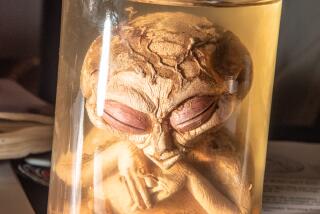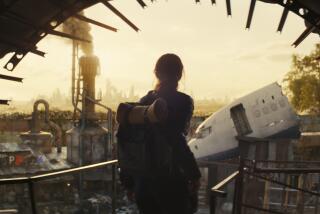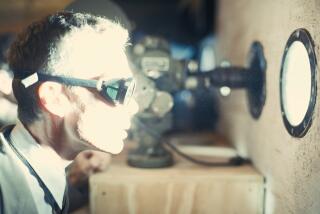The Endless Fascination With Ground Zero : The Bomb 50 Years later
- Share via
The Trinity Site, on the White Sands Missile Range in New Mexico, lies on a stretch of desert that the Spanish explorers called jornada del muerto, “route of the dead man.” It is a faint crater of scruffy grass that one would never notice except for the two concentric fences enclosing it.
On July 16, 1945, when the first atomic bomb was exploded here, a fireball vaporized the tower that held it and fused the sandy soil beneath it. As the mushroom cloud rose to 40,000 feet, roiling with purples and greens, gamma rays and neutrons flashed into the ground and rendered it intensely radioactive. Dust particles and unexploded plutonium, hot in both senses of the world, fell out of the sky onto Trinity--the first nuclear fallout.
After an hour and a half, a Manhattan Project scientist approached in a lead-lined tank. Radiation from the shallow depression was higher than the shielded instruments inside the tank could measure. Grabbing some of the glassy green earth with an exterior scoop, the scientist beat it out of there. Later that day, other researchers eager to collect their data ventured toward the crater without heavy shielding, some more than once. In that era, doctors believed that one could “recover” from radiation exposure.
Newsmen were allowed into the crater two months later, and Trinity was found safe enough for public showings in 1953, a custom that continues to this day. The open house, as the Army calls it, is held on the first Saturday in April and October. The desert heat is too intense for tours in midsummer, but this year the Army will open the site on July 16, the 50th anniversary of the blast.
During an open house, the usually deserted site is transformed. MPs direct traffic, and the parking lots fill up with buses, campers, motorcycles and several hundred cars. A line of booths sells fast food, books, coffee mugs, festive A-bomb T-shirts. Children play inside the ruin of Jumbo, a cylindrical tank meant to encapsulate the bomb and capture the plutonium in case the bomb fizzled. It wasn’t used in the test because the scientists became confident that their “gadget” would work as planned. Now Jumbo’s huge and brooding steel looks perfect as a Manhattan Project artifact.
People stream in and out of Ground Zero. It’s a wholesome crowd, curious about the history and a bit humbled by the occasion. Even the members of the International Star Trek Fan Club, Trinity chapter, seem levelheaded. The first thing to see is a black obelisk. By following the point of the monument 100 feet in the air, one can visualize where the first A-bomb rested atop its tower. Beside the obelisk is a stub of concrete with twists of metal coming out--the only remainder of the tower.
The spectators then file past a full-scale model of “Fat Man,” the bomb that destroyed Nagasaki. Beyond the model, on the far fence, mounted photos show the construction of the Trinity bomb and a sequence of the awesome detonation.
Nearby, through a hatch in a long, low-roofed shed, one can see a patch of Trinitite, the greenish mineral left by the bomb. Long ago the authorities broke up the glaze and buried it, but chips of Trinitite can still be found in the dust of the crater. People are warned not to touch or take any, not so much because of its lingering radioactivity, but because the crater could be picked clean of what is considered a historic resource.
At last the visitors come to Lisa Blevins. An Army health-physics technician, her job is to convince the visitors that their fear of radiation is overblown. Standing behind a small table covered by a red cloth, she is holding the probe of a Geiger counter over a cluster of objects. The objects are causing it to click. With a note of triumph she announces, “this orange saucer is Fiestaware. Some of you may have eaten off of Fiestaware in the ‘50s. It has uranium in the glaze.” Blevins shows that the saucer is hotter than the pieces of Trinitite she has on display. Other radioactive objects include a radium-dial alarm clock, some uranium samples, an airplane part made of a thorium alloy, and the mantel of a lantern, also treated with thorium. “The Trinitite is probably the least energetic thing on the table,” Blevins says.
“Get a little closer, Norman,” a voice calls from the back of the crowd. “It’ll give you brain cancer.”
Blevins doesn’t hear, or pretends not to. She knows it’s a difficult sell. Most people’s fears of radiation exceed their understanding of it. “The main point,she continues, “is that we’re exposed to low levels of radiation all the time.”
From the exhibit, the ground slopes gently to the nadir of Ground Zero. A sign nearby warns people not to eat, smoke or apply makeup, lest they ingest dust from their fingers. A little later a strong gust whirls through the fence, and the visitors duck and cough.
Probably no one here realizes that plutonium is still faintly measurable in the dust at Trinity. It does not register on the Geiger counters, because plutonium emits a different type of radiation. If an anti-nuclear table were permitted at Trinity, plutonium would be its exhibit A. However, the Los Alamos National Laboratory dismissed the health risks in the early ‘80s. Combining the threats of the faint plutonium and other residual radioactive substances, scientists calculated that a person’s risk of contracting a fatal cancer from visiting the crater would be about 1 in 10 million. The study noted that, whether a person came here or not, his or her risk of dying of cancer was already 1 in 5.
The crowd thins after noon, and the Army closes the road to the site at 2 p.m. The photos come down, “Fat Man” is trucked away. Tomorrow Trinity will be abandoned, its fences breached by meadowlarks and dust devils, just a thumbprint beneath the banded front of the Oscuro Mountains.
The road to the crater will be open from 5 to 11 a.m. on July 16, giving people enough time to arrive for the exact anniversary--5:29:45 a.m.--and enough time to leave before the radiation from the sun becomes truly dangerous.
More to Read
Sign up for Essential California
The most important California stories and recommendations in your inbox every morning.
You may occasionally receive promotional content from the Los Angeles Times.










